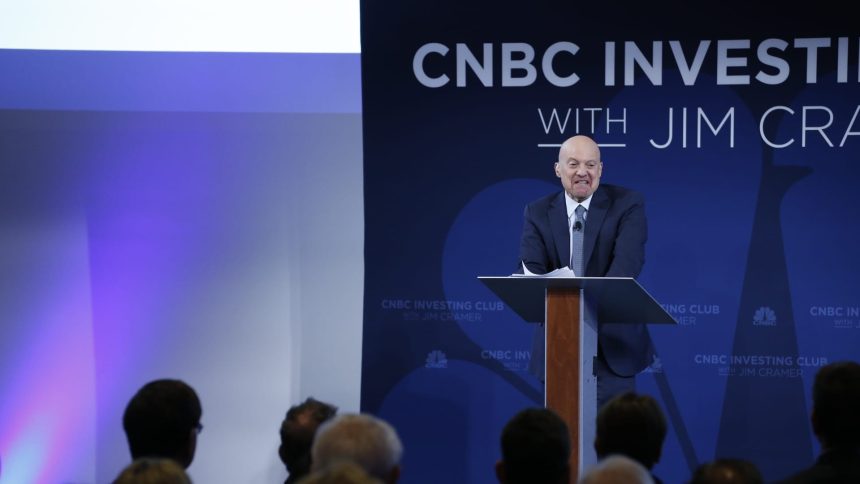The following commentary on six key rules to invest like Jim Cramer was adapted from the CNBC Investing Club’s second annual meeting , which was held on Saturday in New York City, and past dispatches about Jim’s broader 25 investing principles . 1. Bulls and bears make money, pigs get slaughtered: This is closely tied to the notion that discipline trumps conviction. Discipline keeps you in the game and staying in the game is the most important factor in long-term investing. As discussed during the Club’s annual meeting, the big keys to making money long-term are (1) not having big losers and (2) not giving back large gains. We most recently demonstrated our adherence to this rule with our first trade of 2024, when we trimmed eight mega-cap tech stocks that significantly outperformed last year. As noted in the trade alert, we made these sales because we were feeling greedy, not because we had soured them. After all, these eight are, in our view, among the greatest companies in the world. The names trimmed were our Significant Six — Apple , Alphabet , Amazon , Meta Platforms , Microsoft and Nvidia — plus, Palo Alto Networks and Salesforce . You aren’t always going to be correct and many of these stocks just kept going up and up after our sale. However, booking some gains was the disciplined move and that’s what we have to do. What happened with Palo Alto Networks shortly after that trade is a perfect example of why you can’t be greedy. We sold at around $286 (though our alert went out with shares closer to $293). Yes, shares did then proceed to rip higher, topping out at around $377 apiece. Do we wish we held on and sold at $377, obviously, but hindsight is 20/20 and to think you can time it every time and sell right at the tippy top is simply put, wishful thinking. One bad earnings report later and shares plummeted last week to about $262 per share, roughly 8% below our selling price. Had we not made that prior sale, we would not have been as well positioned to take advantage and buy the decline, which we told members to do last week and which we did Monday after our restrictions lifted. Palo Alto shares as of Tuesday’s session highs touched $327 and change. Now it’s not always going to be that extreme — but the point remains, you aren’t going to time every turn in a stock, you may get lucky here and there, nailing a top and/or bottom. However, what you can do consistently is book profits as stocks grind higher and set yourself to repurchase those shares you really believe in long-term on declines. In any other walk of life outside of investing, there comes a price for something we are not willing to pay and where we would instead look to sell. When it comes to stocks, investors often lose that sensitivity to price, and it is a recipe for disaster. So know what you own, what you are willing to pay, and at what price it makes more sense to be a seller than a buyer. 2. Look for broken stocks, not broken companies: It’s important to understand that while stocks represent ownership in a company, a stock and a company are not the same. You must be able to differentiate the two. There is no level too low to sell a broken company. Investors buy companies that directly pay them to own it via buybacks and dividends because they think the stock price will go higher as the fundamentals and earnings power improve. If you don’t have one of those two factors working for you, it’s because the company is broken. On the other hand, if you find a great company with a broken stock, the price will eventually follow the strong fundamentals. This is exactly the kind of opportunity every investor is looking for, one in which the stock is not accurately reflecting the underlying fundamentals. Your job is to get the position before everyone else figures it out. The portfolio holding that comes to mind when thinking about this discipline is GE Healthcare . This was a tough stock to own in the fall of 2023 as it plummeted over 20% from July to October on a mix of concerns from GLP1 to Chinese demand. However, as painful as it was, our homework, which included conversations with management and calls to key customers, kept leading us to the same conclusion, which was that the stock price simply wasn’t reflecting the underlying business fundamentals. Abbott Labs is another example. Though we weren’t in the stock at the time, we were listening to what management had to say during their most recent earnings release and it was clear to us that the positive things we were hearing from management were not being reflected in the price action of the stock. 3. Own the best of breed; it is worth it: When it comes to investing, a real investor runs toward selling, not away. So, when the price of an asset declines, you want to be ready and willing to buy more. That is a whole heck of a lot easier to do when you know that you own the top company in its industry. Palo Alto Networks is a perfect example of this as well. The reason we were able to advise members to hop on last week’s post-earnings decline is because Palo Alto Networks truly is a best-of-breed name in cybersecurity. We didn’t see anything on the earnings release or hear anything on the conference call that led us to believe otherwise. As The Oracle of Omaha Warren Buffett once said, “It’s far better to buy a wonderful company at a fair price than a fair company at a wonderful price.” Owning best of breed, allows us to worry more about higher-level issues than whether or not management is executing. 4. Patience is a virtue – giving up on value is a sin: Patience is the greatest advantage home-gamers have over hedge funds. Nobody is sitting there, threatening redemptions if you don’t perform every three months. Use that to your advantage and let a good story play out. If a stock does nothing for 18 months before going on a 40% run in six months, that’s a heck of a good investment. The latest example of this in the Club, which we highlighted during our annual meeting, is in Disney . Tempting as it has been to give up on this one, we just can’t do it when we see the value there is in the assets. That has also attracted an activist investor like Nelson Peltz. ESPN, Disney+, and theme parks – we just can’t give up on the value we see here. We like the last quarter, which came with a dividend increase and positive profit margin performance and there is a buyback at work. Given the talent and content Disney has, along with the strength in theme parks and optionality in ESPN, there is simply too much value to be unlocked to walk away now at these depressed levels. Our issue is with how those assets are being managed. But we think the heat of an activist investor is what’s needed to get more a capable team in there working to our advantage. That’s why Jim said he’s going to support Peltz’s fight to get Disney board seats. 5. Wait until you have read the press release and heard the conference call: If you can wait, don’t pull the trigger. If you can’t wait, go do something else not connected with stocks. You’re going to save a lot of money. You just don’t know enough. We see this time and again when people want to jump the gun based on some sort of bogus intuition. Sure, you might be correct, but we see all kinds of bizarre swings in shares. Stop, listen, and after checking what the Wall Street consensus is looking for, consider making a trade. Don’t take your cue from the action, take your actions from knowledge. Look no further than Danaher ‘s fourth-quarter earnings release and price reaction. The press release comes out, shares start tanking on a soft outlook. Suddenly, after losing 4% or 5%, the stock turns as the conference call gets underway and management starts talking about how things are starting to normalize and that we may well see meaningful growth in the bioprocessing end market in the back half of 2024. Microsoft is another prime example. The price action that takes place on the press release when this company reports earnings is comical. The reason: If you know anything about Microsoft’s earnings reports, you know that forward guidance isn’t provided on the release and isn’t addressed until about two minutes into the call, long after the results are published. It’s impossible to have all the crucial information you need without listening to what management says on the call. 6. Don’t Buy all at once: Accept that you will never be correct 100% of the time and use that knowledge to your advantage. If you think you can pick the bottom consistently, without luck, well you are wrong and arrogant. As we do for Jim’s Charitable Trust, the portfolio we use for the Investing Club, buy incrementally. We may speed up the buys if we see better prices or average them out over time if we don’t, allowing time for the earnings to grow and the stock to become cheaper. We are never buying an entire position in one fell swoop. A recent example of this can be seen in our purchase of Broadcom . We did all the homework we could, got our position on, and sought to build it up as we saw several catalysts on the horizon including the ramp-up AI data center investments and the then-pending acquisition of VMware. However, we were keen on making sure we left room to add more on pullbacks. Thankfully, we did because a pullback was indeed in store. As shares fell to the low-$800s, we were in a position to take advantage. Broadcom has recently been hitting an all-time high after all-time high, with shares trading around $1,300 each on Tuesday. (See here for a full list of the stocks in Jim Cramer’s Charitable Trust.) As a subscriber to the CNBC Investing Club with Jim Cramer, you will receive a trade alert before Jim makes a trade. Jim waits 45 minutes after sending a trade alert before buying or selling a stock in his charitable trust’s portfolio. If Jim has talked about a stock on CNBC TV, he waits 72 hours after issuing the trade alert before executing the trade. THE ABOVE INVESTING CLUB INFORMATION IS SUBJECT TO OUR TERMS AND CONDITIONS AND PRIVACY POLICY , TOGETHER WITH OUR DISCLAIMER . NO FIDUCIARY OBLIGATION OR DUTY EXISTS, OR IS CREATED, BY VIRTUE OF YOUR RECEIPT OF ANY INFORMATION PROVIDED IN CONNECTION WITH THE INVESTING CLUB. NO SPECIFIC OUTCOME OR PROFIT IS GUARANTEED.
Read the full article here




